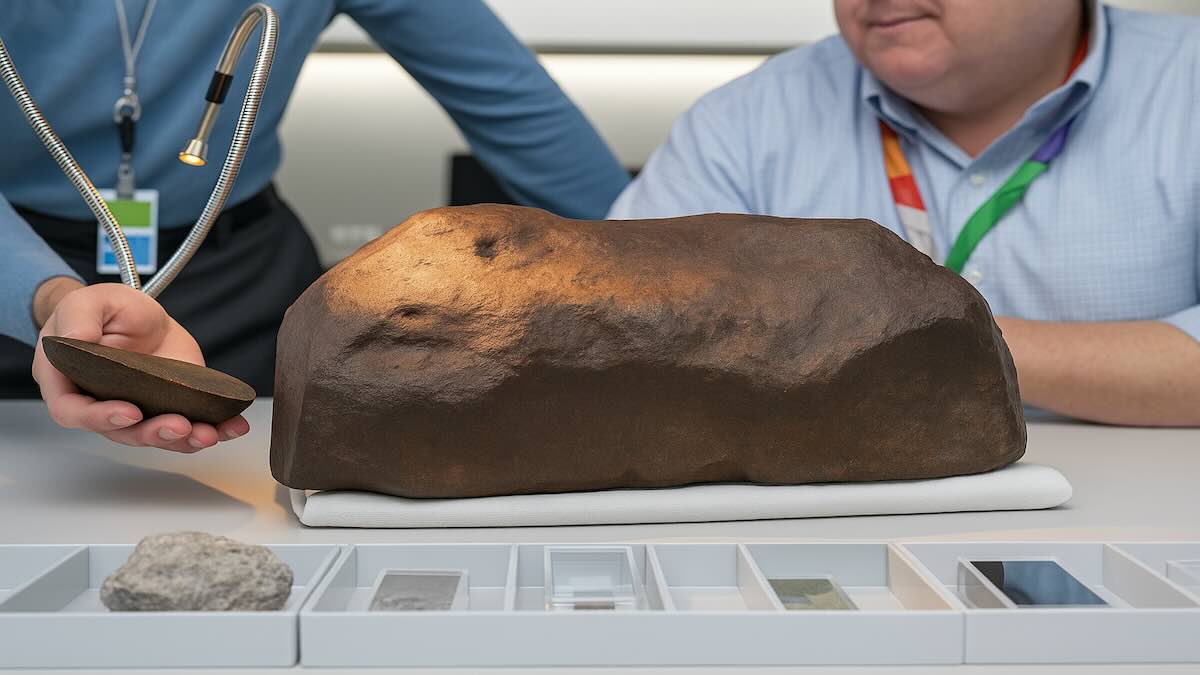During a quiet walk, an ordinary glance at the ground turned into a turning point. What seemed like just a strange rock quickly captured attention with its unusual weight and texture. The finder could not have imagined that this small object would draw scientists and appraisers into a full investigation. Beyond its appearance, the rock carried exceptional characteristics that placed it among the most remarkable discoveries of its kind. Its eventual recognition shows how the most unexpected moments can hold extraordinary value.
Understanding chance finds and why they matter
Most meteorites begin as unnoticed fragments until someone spots unusual clues: greater heft than ordinary rocks, a strong pull to a magnet, a dark fusion crust from atmospheric entry or thumb-like surface dimples. Metal-rich specimens, in particular, can become scientific reference pieces and coveted collectibles. Their appeal is twofold. First, they preserve early solar system history in a compact form.
Furthermore, their makeup—typically iron-nickel compounds containing minor components—establishes scarcity categories that determine worth. This explains how a garden finding can transform into a collection-worthy example: not due to visual appeal, but through uncommon nature, excellent condition and educational potential.
The parallel with NASA’s Psyche proves valuable: whereas Psyche represents a complete metallic celestial body, an individual metal-heavy space rock provides a portable equivalent that scientists can examine immediately, shaping theories regarding planetary centers, impacts and developmental mechanisms.
Quick field indicators that help (without replacing lab work)
- Heavier than expected for its size
- Responds to a magnet
- Thin, dark fusion skin; interior often metallic or speckled
- Smoothed dimples or regmaglypts on the surface
How a strange rock becomes a confirmed meteorite
Confirmation is a stepwise process. Finders document where and how the specimen was discovered, then consult a university, museum or accredited laboratory. Specialists examine the exterior for fusion crust and regmaglypts, test magnetism and density, and take a tiny sample for microscopy. If it looks promising, they proceed to classification and formal appraisal based on type, rarity and condition. Only after that chain of evidence do appraisers discuss market value, conservation and placement—whether in a public collection, private sale or shared research program.
How labs test suspected meteorites
Technicians typically combine non-destructive checks (magnetic susceptibility, density measurements, X-ray imaging) with micro-scale sampling. Under the microscope, texture and metal distribution reveal whether it’s an iron, stony-iron or stony meteorite and whether it fits a recognized classification.
Mistakes that ruin specimens
Avoid cutting, grinding, polishing or washing with chemicals. Don’t oil the surface or store it in humid containers. Keep the stone dry, bagged and labeled with the exact find location, then let specialists do the first cut if needed.
What a $3.6 million meteorite means for science and owners
A seven-figure valuation signals that the specimen is rare, well-preserved and important to research. For scientists, such a stone can calibrate instruments, anchor publications and fill gaps in planetary histories. For owners, it introduces responsibilities: safeguarding provenance records, maintaining stable storage conditions and deciding on access.
Many choose a hybrid path—loaning the piece for study while retaining ownership or sharing a small, documented slice for laboratory work. Marketwise, appraisals reflect type (iron vs. stony-iron vs. stony), classification scarcity, size and aesthetic features. Because laws vary, finders should note that permissions, export rules and cultural property restrictions may apply; institutions can advise on the correct procedure before any sale or donation.
Checklist before speaking to an expert
- Photograph the stone in place and after collection
- Record GPS coordinates, date, time and circumstances
- Store it dry, padded and separate from magnets or metal tools
- Note simple observations: weight feel, magnet response, exterior skin
- Contact an academic or museum laboratory for guidance
Beyond Earth: context from NASA’s metal-rich Psyche mission
NASA’s Psyche mission focuses on a metal-rich asteroid to probe how planetary building blocks formed and differentiated. That focus illuminates why metal-dominated meteorites on Earth command attention: they are tangible pieces of similar processes. The link is conceptual, not commercial—Psyche is a scientific mission—but it helps explain why the discovery of a strange rock with unusual density and metallic texture triggers such rigorous analysis.
In the appraisal room, factors mirror scientific priorities: composition, structure, weathering state and provenance. In the marketplace, rarity and intact surfaces matter, as does a clean chain of custody. The $3.6 million valuation in this case reflects more than weight; it reflects a convergence of science, scarcity and condition that few specimens achieve.
Key takeaways and next steps
A heavy, magnetic, fusion-skinned stone found during a casual walk turned out to be a rare meteorite worth $3.6 million after expert testing and formal classification. If you encounter something similar, protect the context: photograph it, record the location, store it dry and avoid cleaning or cutting. Then consult a university or museum lab to confirm identity and discuss conservation and appraisal. That pathway preserves scientific value and maximizes fair market assessment—ensuring that if a strange rock is exceptional, it is documented and handled to the highest standard.
